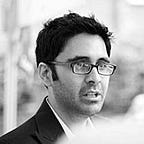Your Weaknesses Are Your Strengths. Embrace Them.
What True Strength Really Is and Where it Comes From
Like all of us, you struggle with weakness and strength. Approaching it logically, we suppose strength is the absence of weakness, and vice versa, right? So we try to build up our strengths and reduce our weaknesses. But often we go in circles, never quite succeeding at either.
We’re wrong. Strength isn’t the absence of weakness. Strength and weakness are one. There can’t be one without the other. Weakness is just the mirror image of strength, and vice versa. They are the very same thing.
Perhaps you are principled, but judgmental. You’re easily hurt, but compassionate. You’re focused, but one-dimensional. You are creative, but a mess. Pragmatic, but boring. Humble, but a pushover. Passionate, but maniacal. You’re greedy, but meticulous. You’re brave, but foolhardy. And so on. Perhaps you recognize aspects of yourself even here.
Strength and weakness aren’t separate. They’re just two aspects of the same things in us. When we try to divide them, that is when we fail at both. We are principled, so we try to be less judgmental. And now we are not even principled. We are compassionate, but easily hurt, so we try to be harder, but lose our compassion.
Growth is understanding that greater strength also produces greater, not less, weakness. We can’t divide them. They’re one.
Now we are beginning to have true self awareness. We can at last have three great insights about true strength.
True strength is awareness. Self-awareness is not the game of choosing identities, little bits of ourselves to desire. That kind of love, which celebrates only what it thinks is valuable, is narcissistic. It is as superficial as desiring a person just for the way they look, isn’t it? It’s turning yourself into an object. So that kind of self-love is shallow and narrow, not pure, clear, true.
True strength is never dividing one’s self up into weak and strong to begin with. Always — always — when we divide ourselves, then do fear and anxiety arise. When we have divided ourselves into strength and weakness, and want to excise parts of us, then of course we will be anxious and afraid, will we not? We will always think we are only weak this way, because we can never really get “rid” of our weaknesses at all.
True strength is knowing, experiencing the truth, that in our fragility lies our possibility. And therefore, we must accept not just our strengths, but also our weaknesses. We must love them even more fiercely than we love our strengths, for they are one and the same.
True strength is compassion. It is not just our weaknesses that are our strengths. It is everyone’s. We are all one and the same this way. The oneness of strength and weakness is not just being human, it is just being. It is as true for an ant or a tiger as it is for you. The tiger is swift, but he must eat and eat. The ant is slow, but he can survive the greatest blows. And so on.
Now we can look at every person differently, can we not? With true compassion. The weaknesses we so despise in others also contain strengths, and the strengths we so admire also hold weaknesses.
Now we do not simply have to despise the weak and admire the strong, right? We can have compassion for every single being, including ourselves, and know that they, just like us, are struggling with the oneness of strength in weakness, and weakness in strength. So we do not have to judge them against us, or us against them, anymore.
We have a more sophisticated way of seeing people now, through to the truth of them. There is no us and them, no separation. No matter how superficially “different” they may appear to be, we are all walking the same path home.
True strength is perspective. Now we arrive at the last, most difficult part of self-awareness. We, as Whitman said, contain multitudes. We are not just weak or strong. We are weak and strong. So we must see ourselves totally differently. We can’t simply idealize ourselves as one dimensional beings anymore. We must learn to know ourselves as contradictions. Sometimes we are weak, sometimes we are strong.
And that is just how it should be.
Is the river weak or strong, when the water flows around the rocks? Is the tree weak or strong, when it bends in the wind? Is the glacier weak or strong, when the ice melts? Lao Tzu called all this actionless action. It is the idea that the truly mighty things are weak and strong, not weak or strong. Like the river, the tree, the glacier, they do not always act, do they?
Weak and strong are just matters of perspective now, are they not? Sometimes, what we call weakness is strength, and strength weakness. Is it strong or weak to prevent an enemy from being hurt? Is it weak or strong to love someone for their fragility? Now you understand the principle of actionless action a little. It is not a matter of either/or, but both. The whole is greater than the parts.
We need to be not weak or strong to be mighty, but weak and strong to be mighty, which is what true strength is. The river, the tree, the glacier, all the forces of nature are mighty not because they are weak or strong, but because they are weak and strong.
And so are you.
Therefore. You are the mightiest thing in all creation. All of being is in you. Weak and strong. That is all that true strength really is.
Umair
London
May 2016
